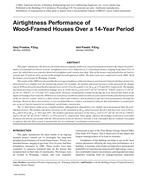Description
This paper summarizes the most recent results from an ongoing, multi-year research program to monitor the long-term performance of residential air barrier systems. Airtightness tests were conducted on 22 wood-frame houses, ranging in age from 10 to 14 years, for which there was extensive historical airtightness and construction data. Nine of the houses used polyethylene air barrier systems and 13 used an early version of the airtight drywall approach (ADA). The latest tests were conducted in early 2000. All of the houses were located in Winnipeg, Canada.
The results of the 2000 tests showed that the average airtightness of the nine houses constructed with polyethylene air barriers deteriorated very slightly over the monitoring period. For example, the median and mean increases in the measured air change rate at 50 Pa (ac/hr50) between the first and last tests were 0.16 ac/hr50 and 0.21 ac/hr50, or 15% and 30%, respectively. The median and mean increases in the normalized leakage area at 10 Pa (NLA10) were 0.075 cm2/m2 (0.108 in.2/100 ft2) and 0.112 cm2/m2 (0.161 in.2/100 ft2), or 11% and 35%, respectively. However, examinations conducted during the tests showed that much of the major air leakage observed in the 2000 tests occurred at accessible locations not directly associated with the polyethylene portions of the air barrier system, such as at floor drains, doors and windows, and mechanical and electrical penetrations through the envelope. Based on these observations, it was concluded that no evidence was found to indicate that polyethylene is unsuited for use as an air barrier material in residential, wood-frame construction.
The 13 ADA houses behaved in a similar fashion, although their degradation was slightly more pronounced than the polyethylene houses. The median and mean increases in the measured ac/hr50 values between the first and last tests were 0.40 ac/ hr50 and 0.38 ac/hr50, or 38% and 38%. The median and mean increases in the NLA10 were 0.157 cm2/m2 (0.226 in.2/100 ft2) and 0.150 cm2/m2 (0.216 in.2/100 ft2), or 39% and 41%, respectively. Once again, much of the leakage occurred at accessible locations not directly associated with the ADA portions of the air barriers. Overall, it was concluded that no evidence was found to indicate that the ADA system is unsuited for use in residential, wood-frame construction.
Citation: Thermal Performance of Exterior Envelopes of Whole Buildings IX
Product Details
- Published:
- 2004
- Number of Pages:
- 9
- File Size:
- 1 file , 2.4 MB
- Product Code(s):
- D-BldgsIX93




